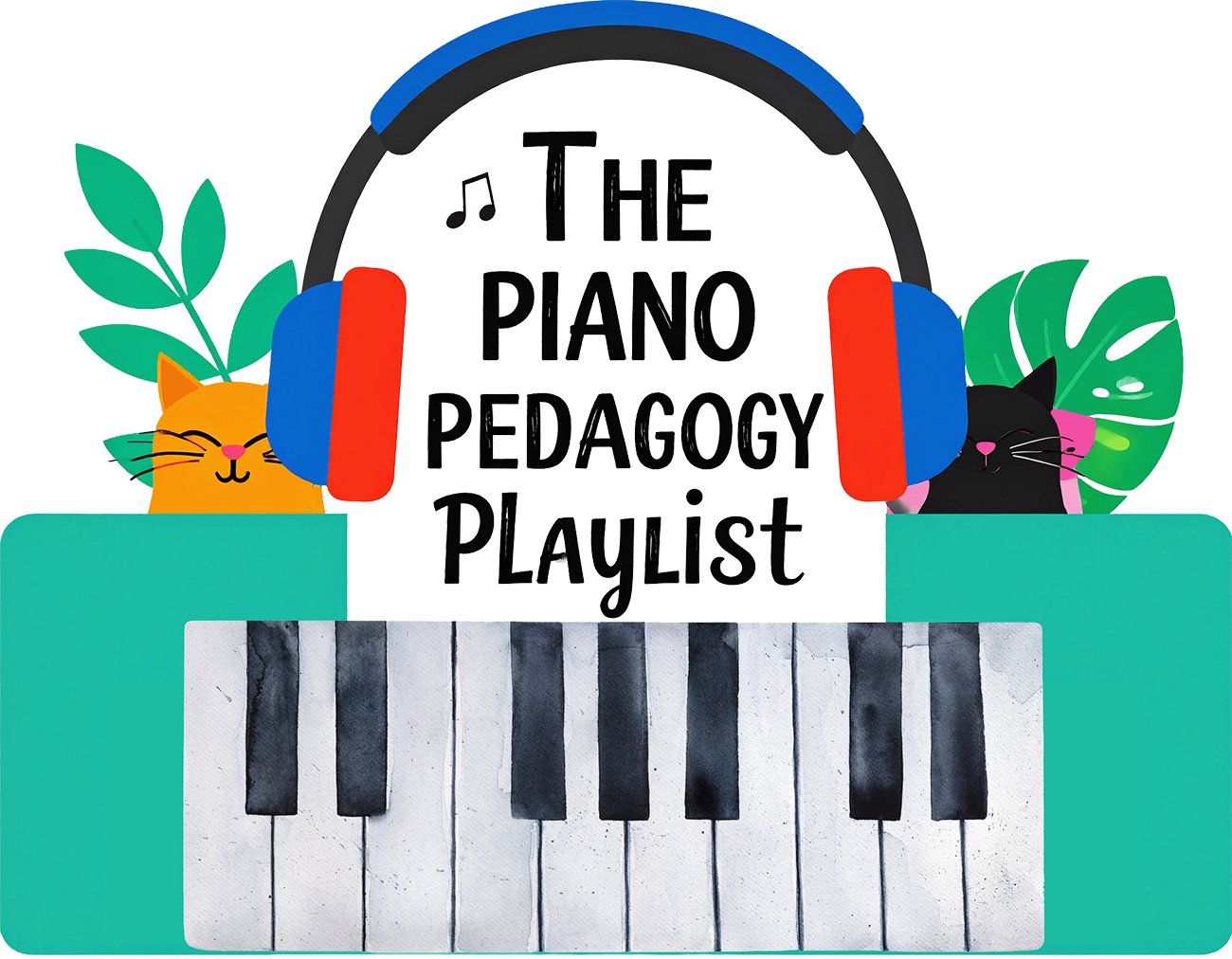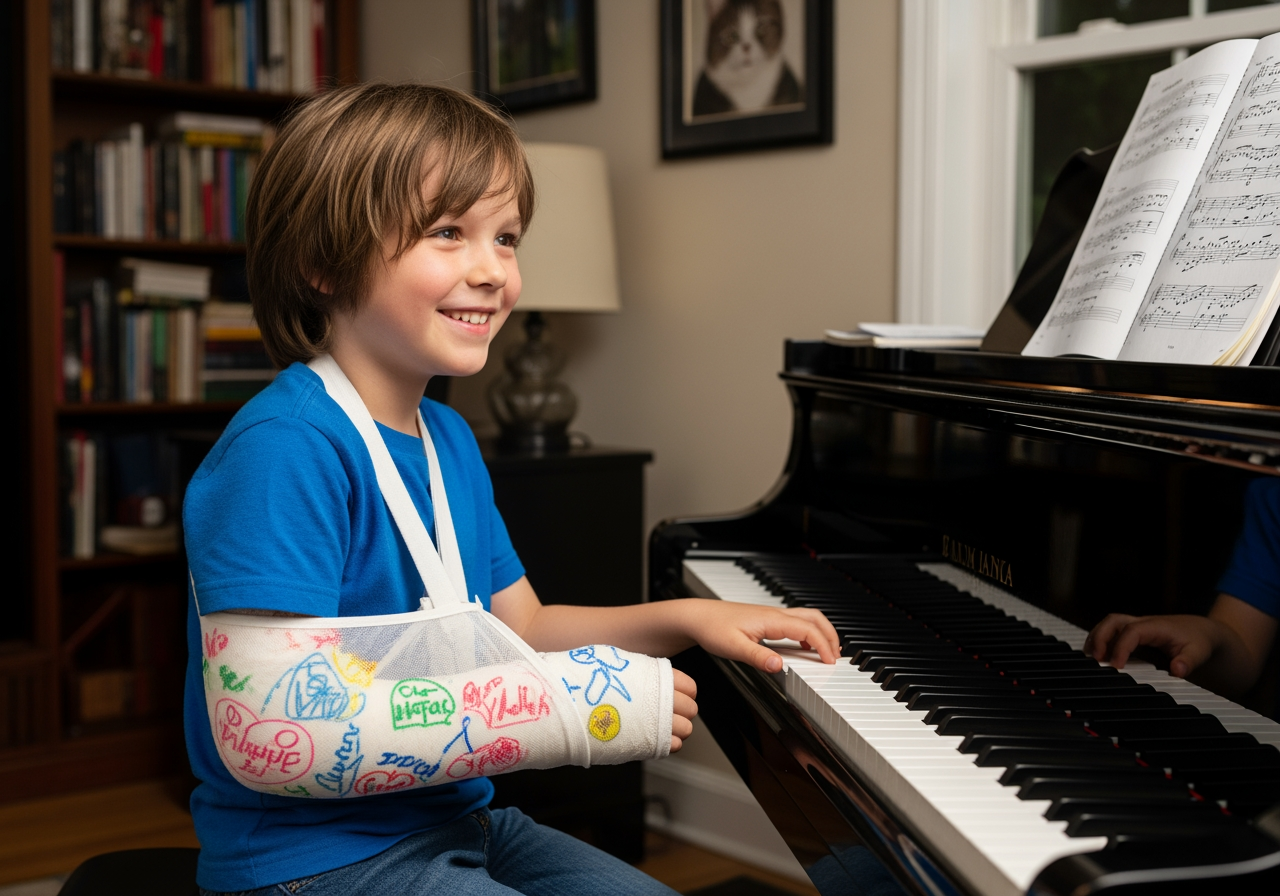
All of this week’s featured pieces are from the six-volume series, “Grand One Hand Solos for Piano”, by Melody Bober.
Lazy Day, for left hand alone – Digital Download (from book 2, Digital Download Printed Copy)
Falling Snow, for right hand alone – Digital Download (from book 3, Digital Download Printed Copy)
Autumn Wind, for left hand alone – Digital Download (from book 4, Digital Download Printed Copy)
Chaconne in e minor, for right hand alone – Digital Download (from book 5, Digital Download Printed Copy)
When an injury leaves one hand out of commission, the music doesn’t have to stop. This week, I’m featuring pieces from Melody Bober’s Grand One-Hand Solos for Piano series— music written specifically for a single hand that keeps students progressing even through recovery.
— Transcript —
So, it’s November, and for many of our students, fall sports and activities are winding down, winter ones are starting up, and piano teachers everywhere are bracing themselves for the seemingly endless balancing act of schedules, games, rehearsals, and sometimes unfortunately injuries.
You’ve probably had the experience of having a student show up to their lesson with their arm in a sling or a cast, or fingers that have been jammed and then taped together. Oftentimes without any warning.
Parents might be inclined to just have their child take some time off, but teachers know that a multi-week or heaven forbid, a multi-month break from lessons can be not good, especially if we have some momentum going with the student. Being prepared with some one-handed repertoire at the ready can be useful in assuring parents that we can continue to work on technique and musicality with the unaffected hand. And it helps if that music still sounds interesting and, well, musical, even while utilizing only half the regular number of fingers.
So in this week’s episode, I’ve chosen four pieces to play for you from Melody Bober’s Grand One Hand Solos for Piano series. A collection that spans six volumes from early elementary to late intermediate levels. A collection of pieces that does it all. Single-handedly. Coming up next on the Piano Pedagogy Playlist.
Greetings and welcome to all you keepers of the Keys. I hope your day is going well. My name is Luke Bartolomeo. I’m a pianist, a teacher, and I also make apps helping students who are studying music, including Flashnote Derby. Each Monday on the Piano Pedagogy Playlist, I play for you some of my current favorites from the contemporary repertoire of music written for piano students. Today’s selections are all by Melody Bober, from her series, Grand One Hand Solos for Piano. And as you’ll hear, these aren’t make-do type pieces. You’d be hard pressed to identify them as one-handed pieces, even when looking at the score. They’re expressive, well-crafted, and pianistic in their own right or left.
Now, I’m going to bypass the selections from Book 1, because I feel like a lot of the early elementary repertoire is already written for one hand or could be easily adapted. But Book 1 does have some nice pieces, all with teacher duets to help fill out the sound.
I’ll begin instead today with a piece from Book 2 called Lazy Day. It’s gentle and lyrical, written for left hand alone. Now, shaping a phrase to imitate how it might naturally sound if being sung by the human voice is one of the most basic skills we work to develop in our students from the very beginning.
Most of the time, we’re dealing with the right hand when working on phrasing and lyricism. Now it’s true, many pieces give the left hand a chance to take the melody, but a piece in which there’s nothing to focus on except our left hand allows even deeper focus on developing its singing skills to the same proficiency level as our right hand. Here’s Lazy Day from the Level 2 Book of Grand One Hand Solos for Piano by Melody Bober.
Do you see what I mean about that being a very useful teaching piece for one hand, but also something that sounds very complete, like a typical repertoire piece for both hands for a student at this level.
Now our next piece comes from Book Three, and it is called Falling Snow. This one has a similar structure, very similar to Lazy Day. There’s a lyrical melody in the treble register, and there are open fifths again, forming the harmonic bass. But this time it’s indicated for right hand alone. Of course, with one-handed pieces, there’s often flexibility, not always, but oftentimes.You could assign this piece to the left hand instead, and it would work equally well.
One little performance note, I do take a few liberties with the pedaling. In certain spots, I change the pedal a little less often than indicated in the score. By doing this, I can let some of the lower harmonies resonate longer, and to me, it just helps perpetuate the illusion of this being a piece for two hands. Here’s Falling Snow from Book 3.
So peaceful, right? And very good practice for evenness when playing all those alternating thirds.
Moving on now to an intermediate level piece.
From Book Four, we have a selection called Autumn Wind. This one’s again indicated for left hand alone. And unlike the previous two pieces, I think it would be a little more difficult to adapt it for the right hand.
It begins with some sweeping arpeggio type figures that are extremely typical of what the left hand often uses to accompany a melody. As it unfolds, the arpeggio eventually expands into the treble register and becomes the melody itself. There’s ample opportunity to work on smooth finger crossings and controlled changes in dynamics. Here’s Melody Bober’s Autumn Wind.
And now we’ll finish up and keep things evened out with another piece for Right Hand Alone. Something a little bolder, this is from Book Five, Chaconne in E Minor.
The musical form Chaconne started out as many forms from the Baroque did, as a dance. The Chaconne is stately and dignified in nature. And its main defining element is that it has a short harmonic progression that repeats in a series of variations. Most typically a Chaconne is in triple meter, but this example happens to be in 4-4.
The main challenge with this piece is maintaining the rather brisk tempo and pulling off all of the rapidly shifting hand positions. You have to shift quickly, but then have to land gently in control.
I teach my students the way I was taught, that you have to arrive at least a few milliseconds early to each new position to keep control of the sound. You can’t just crash into the new position, or all of that momentum will result in a splatty accented sound. And that’s definitely not what’s needed here. Here’s Melody Bober’s Chaconne in E Minor from Book 5.
I think that’s a strong piece to end on, full of motion and energy, and that middle section that exudes confidence.
Now, while it’s obvious how useful these pieces could be for students who’ve suffered an injury, don’t discount their value for your fully functioning pupils as well. They’re wonderful for building technique, coordination, and especially musical awareness, while focusing on just one hand at a time. And they don’t give up anything in terms of musicality.
There are six volumes in the Grand One Hand Solos for Piano series by Melody Bober, each with about six to eight pieces. All of the pieces are available individually for digital download, so you don’t have to commit to buying an entire volume. However, if you think you might be wanting more than two pieces in any particular book, it’s going to be cheaper to buy the whole book. But I will add that I find these prices extremely reasonable.
You can find links to the individual pieces I played today, as well as to each book in the collection by looking in the description or by visiting my website pianopedagogyplaylist.com.
In the interest of full disclosure, if you click on any of my links to make a purchase, it does help a bit financially to support the podcast. However, if you’re fortunate enough to have a brick and mortar sheet music store nearby, and you don’t need digital scores, I’d honestly be just as happy for you to support your local business.
Just like that, we have to close the lid on today’s episode of the Piano Pedagogy Playlist.
Whether your students are practicing with one hand or two this week, remember the most important thing is to keep making music. Creativity often grows when faced with limitation. I’ll look forward to seeing you again next Monday, when I’ll share some more of my current favorites from the contemporary piano teacher’s repertoire.Until then, keep nurturing the music, and have a great week.




Leave a Reply